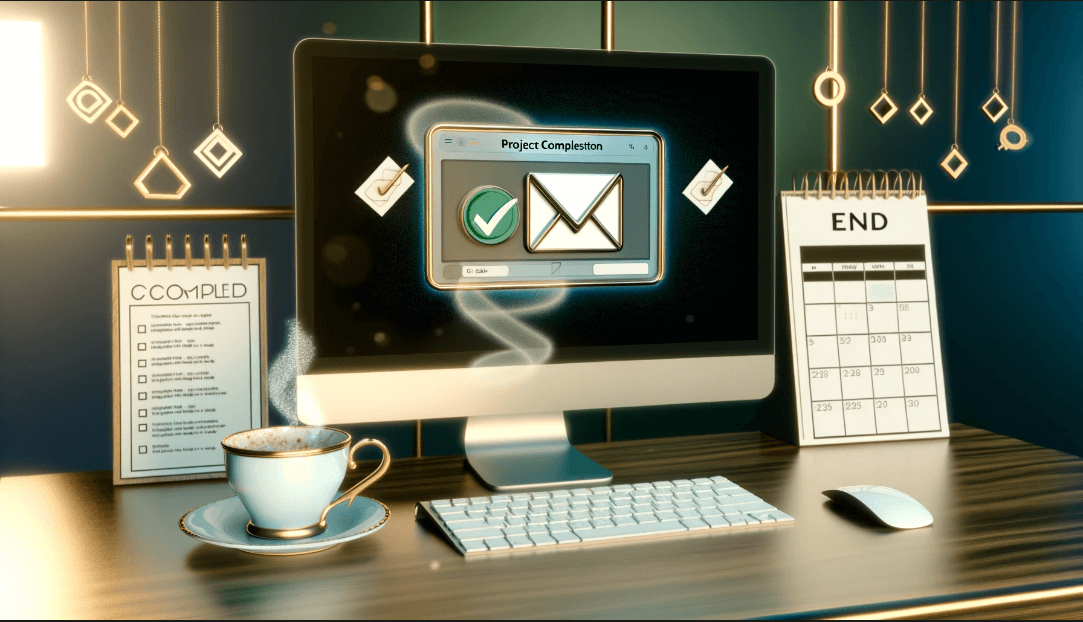The conclusion of a project marks a significant milestone for any team, serving as a pivotal moment to reflect on achievements, overcome challenges, and recognize the collective efforts involved. Crafting a project closure email that encapsulates these elements is crucial for providing closure and celebrating the journey. This article aims to offer you five distinct, attractive templates designed to cater to a variety of project closure scenarios, ensuring your final communication is as impactful as the project itself.
Importance of a Well-Crafted Project Closure Email
Project closure emails play an integral role in project management. They not only signify the completion of a project but also foster a sense of achievement among team members, providing a sense of closure and readiness for future endeavours. A well-crafted email can boost morale, encourage reflection on successes and lessons learned, and strengthen team cohesion. It’s an opportunity to acknowledge hard work, celebrate successes, and pave the way for future projects with optimism and clarity.
Here are some key points highlighting its importance:
- Acknowledgement of Team Effort: It recognizes the hard work, dedication, and contributions of each team member, validating their effort and fostering a sense of accomplishment
- Summary of Achievements: Provides a comprehensive overview of the project’s successes, milestones reached, and objectives met, celebrating the team’s achievements.
- Reflection on Challenges and Lessons Learned: Encourages a reflective look at the challenges encountered and the lessons learned throughout the project, which can be invaluable for personal growth and improvement in future projects.
- Feedback and Appreciation: Offers a platform for giving and receiving feedback, and for expressing appreciation for the team’s perseverance and commitment, which can boost morale and motivation.
- Documentation for Future Reference: Acts as a formal record of the project’s completion, including outcomes and insights gained, serving as a valuable resource for future projects.
- Clear Communication of Project Closure: Officially marks the end of the project, ensuring everyone is on the same page and preventing any confusion about the project’s status.
- Facilitates Transition to Future Projects: By providing closure, it helps team members transition more smoothly to upcoming projects, with a clear mind and renewed focus.
- Strengthens Team Cohesion and Culture: Reinforces a culture of recognition, learning, and continuous improvement, contributing to stronger team cohesion and a positive work environment.
- Encourages Professional Growth and Development: By highlighting accomplishments and areas for improvement, it supports the professional development of team members, encouraging them to leverage their strengths and address weaknesses in future endeavours.
- Sets a Positive Precedent: Establishes a standard for how projects are concluded, emphasizing the importance of reflection, recognition, and continuous learning in the organization.
Template 1: Standard Project Completion

Overview
This template is tailored for formally acknowledging the completion of a project, highlighting key achievements, and outlining the next steps. It’s ideal for projects that have met their goals within the expected parameters, celebrating success while maintaining a professional tone.
Key Elements
- Gratitude Expression: Begin with a thank you to the team for their hard work and dedication.
- Achievement Highlights: Summarize the project’s key achievements and milestones.
- Future Directions: Provide a brief overview of next steps or upcoming projects.
When to Use
Use this template for projects that have achieved their goals straightforwardly, where a formal yet appreciative tone is appropriate.
Example:
Dear [Team/Individual Name],
As we wrap up [Project Name], I want to extend my sincere gratitude to each one of you for your hard work and dedication. Our collective effort has led to numerous achievements, including [Briefly list key achievements].
Looking ahead, [outline any follow-up actions, future projects, or next steps]. Your continued commitment and expertise will be crucial as we move forward.
Thank you once again for your invaluable contribution to making [Project Name] a success. Here’s to our next venture together!
Warm regards,
[Your Name]
[Your Position]
[Your Contact Information]
Template 2: Celebratory Closure
Overview
Designed for projects that exceeded expectations or required significant teamwork, this template emphasizes celebration and team effort.
Key Elements
- Team Highlights: Acknowledge the collective effort and specific contributions.
- Special Shoutouts: Offer personalized acknowledgements for outstanding contributions.
- Forward-Looking Statement: Encourage enthusiasm for future projects.
When to Use
Ideal for milestone achievements or projects that went above and beyond, fostering a sense of pride and accomplishment.
Example:Subject: 🎉 Celebrating Our Success: [Project Name] 🎉
Dear Team,
What an incredible journey [Project Name] has been! Thanks to your unparalleled teamwork and effort, we’ve not only met but exceeded our goals. Special shoutouts to [mention any individuals or teams deserving of special recognition] for [specific contributions].
Let’s carry this momentum into our next projects, with the same spirit and dedication that made [Project Name] a remarkable success. Here’s to many more achievements together!
Cheers to you all!
[Your Name]
[Your Position]
[Your Contact Information]
Template 3: Reflective Project Closure
Overview
Suited for projects with significant learning experiences, this template encourages reflection on the journey, challenges faced, and growth achieved.
Key Elements
- Memorable Moments: Share impactful moments or turning points in the project.
- Lessons Learned: Highlight valuable insights gained throughout the project.
- Appreciation for Resilience: Recognize the team’s perseverance and adaptability.
When to Use
Best for projects that were particularly challenging or provided substantial growth opportunities, promoting reflection and appreciation.
Example:
Subject: Reflecting on Our Journey Through [Project Name]
Dear [Team/Individual Name],
As [Project Name] comes to a close, it’s important to reflect on the journey we’ve embarked on together. This project presented us with challenges, but through resilience and determination, we’ve learned valuable lessons, including [List a couple of lessons learned].
Your hard work and perseverance have been truly inspiring. Thank you for your dedication and for the growth we’ve achieved together.
Looking forward to our next adventure and the lessons it will bring.
With appreciation,
[Your Name]
[Your Position]
[Your Contact Information]
Template 4: Brief and Professional Closure

Overview
This template is perfect for straightforward projects that conclude without major hurdles, focusing on succinct acknowledgements and next steps.
Key Elements
- Concise Acknowledgments: Briefly thank the team for their efforts.
- Summary of Next Steps: Outline immediate follow-up actions or documentation.
- Professional Tone: Maintain a formal and direct approach.
When to Use
Recommended for projects in more formal or corporate settings where brevity and professionalism are key.
Example
Subject: Official Closure of [Project Name]
Dear [Team/Individual Name],
I am pleased to announce the successful completion of [Project Name]. This email marks the formal closure of the project.
I’d like to thank everyone for their contributions. Moving forward, [outline any necessary follow-up actions or next steps].
Let’s continue to uphold the standards of excellence we’ve set, as we transition to upcoming projects.
Best regards,
[Your Name]
[Your Position]
[Your Contact Information]
Template 5: Creative and Engaging Closure
Overview
Ideal for teams with a creative flair or less formal working relationships, this template focuses on unique achievements and engaging the team for future endeavours.
Key Elements
- Unique Achievements: Highlight creative wins or innovative solutions.
- Kudos Corner: Offer fun and personalized shoutouts.
- Engaging Call to Action: Excite the team about upcoming projects with a creative twist.
When to Use
Use this template for projects where team engagement and morale are a priority, especially in creative or less formal environments.
Example:
Subject: 🚀 [Project Name]: A Stellar Wrap-Up! 🌟
Hey Team!
Wow, what a ride! [Project Name] was nothing short of a cosmic adventure, and we absolutely nailed it! 🚀 Huge kudos to [mention any standout contributions], your creativity and hard work launched us to new heights.
Let’s not let this energy fizzle out. Up next, we have [mention the next project or phase], and I can’t wait to see the amazing places we’ll go with your brilliant minds and spirited hearts.
You’re all stars in this galaxy. Let’s keep shining bright!
Rock on,
[Your Name]
[Your Position]
[Your Contact Information]
Conclusion
Choosing the right project closure email template is crucial for effectively reflecting the nature of the project and the team’s culture. These templates are designed to be adaptable, allowing you to tailor them to fit the specific needs and nuances of your project. By selecting and customizing the appropriate template, you can ensure your project closure email not only marks the end of a chapter but also sets a positive tone for future collaborations.
FAQ:
1. What is a project closure email?
A: A project closure email is a formal communication sent to team members, stakeholders, or clients at the conclusion of a project. It summarizes the project’s achievements, acknowledges the team’s efforts, addresses any final matters, and sets the stage for future projects or collaborations.
2. Why is sending a project closure email important?
A: Sending a project closure email is important because it officially marks the end of a project, helps in documenting the project’s success and challenges, recognizes and appreciates the team’s effort, and ensures a clear transition to upcoming initiatives.
3. What should be included in a project closure email?
A: A project closure email should include a thank you note to the team, highlights of the project’s achievements, any lessons learned, acknowledgment of individual or team contributions, and next steps or future projects if applicable.
4. How can I make my project closure email engaging?
A: To make your project closure email engaging, include personalized acknowledgments, share memorable moments or achievements, use a tone that matches your team’s culture, and possibly incorporate visual elements like images or infographics to summarize achievements.
5. Can I use the same template for every project closure?
A: While you can start with a template, it’s best to customize your project closure email to reflect the unique aspects of each project and the contributions of the team involved. Tailoring the message shows thoughtfulness and appreciation for the specific project and its challenges.
6. How soon after project completion should I send the closure email?
A: It’s advisable to send the project closure email shortly after the project is completed and all final deliverables have been approved. This ensures that the project and its outcomes are still fresh in everyone’s minds.
7. Should I include feedback or a survey in my project closure email?
A: Including a request for feedback or a survey in your project closure email can be beneficial for gathering insights and improving future projects. Ensure it’s optional and easy to complete to encourage participation.
8. Is it appropriate to mention project challenges in the closure email?
A: Yes, mentioning project challenges in a constructive manner can be valuable. Highlighting how the team overcame these challenges can serve as a learning experience and celebrate the team’s resilience and problem-solving skills.
9. Can I send a project closure email to clients as well as team members?
A: Absolutely. Sending a project closure email to clients acknowledges their role in the project’s success, summarizes the outcomes, and maintains a channel for future communication and projects.
